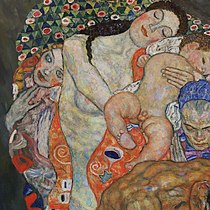art.wikisort.org - Painting
Death and Life (German: Tod und Leben, Italian: Morte e Vita) is an oil on canvas painting by Austrian painter Gustav Klimt. The painting was started in 1908 and completed in 1915.[1] It is created in an Art Nouveau (Modern) style by use of allegorical painting genre during Golden phase. The painting measures 178 by 198 centimeters and is now housed at the Leopold Museum in Vienna.[2][3]
| Death and Life | |
|---|---|
| Tod und Leben | |
 | |
| Artist | Gustav Klimt |
| Year | 1910s |
| Medium | Oil on canvas |
| Dimensions | 1,805 mm (71.1 in) × 2,005 mm (78.9 in) |
| Location | Leopold Museum |
History

In 1911 Death and Life received first prize in the world exhibitions in Rome.[4] In 1912 Klimt exhibited the painting at an art exhibition in Dresden.
Further exhibitions of the painting took place e.g. 1913 in Budapest and Mannheim, 1914 in Prague, 1916 in Berlin, 1917 in Stockholm, 1917/1918 in Copenhagen, 1918 in Zurich and from 1923 several times in Vienna, 1958 in Venice and 1965 in New York and London.[5]
Klimt made changes to the painting in 1915, after the first five exhibitions of the painting. He changed the background from gold-colored to grey and added some mosaics.
Description
This is one of Klimt's central themes, central also to his time and to his contemporaries among them Edvard Munch and Egon Schiele.[6][7] Klimt makes of it a modern dance of death, but unlike Schiele, he introduces a note of hope and reconciliation, instead of feeling threatened by the figure of death, his human beings seem to disregard it.[8] The imagination of the artist is focused no longer on physical union, but rather on the expectation that precedes it. Perhaps this new found serenity is rooted in Klimt's own awareness of aging and closeness to death. But before the moment came when he chose to depict nothing more than moments of intense pleasure or miraculous beauty and youth.[9][10]
References
| External video | |
|---|---|
 | |
- "Gustav Klimt | Highlights | COLLECTION | Leopold Museum". www.leopoldmuseum.org. Retrieved 2020-11-17.
- "Gustav Klimt, Death and Life". Leopold Museum. Retrieved 7 April 2013.
- Bade, Patrick (2011-07-01). Gustav Klimt (in French). Parkstone International. ISBN 978-1-78042-283-1.
- "Biography - klimt-foundation.com". www.klimt-foundation.com. Retrieved 2020-11-17.
- Klimt, Gustav; Marlborough Fine Art Ltd. (1966). Gustav Klimt: paintings and drawings: [exhibition], October-November 1965, Marlborough Fine Art Limited ... [et al.]. London: Marlborough Fine Art Ltd.
- Lightfoot, D. Tulla (2019-02-21). The Culture and Art of Death in 19th Century America. McFarland. ISBN 978-1-4766-3518-7.
- Arnason, H. Harvard (1968). History of Modern Art: Painting, Sculpture, Architecture. H. N. Abrams.
- Cavallaro, Dani (2018-01-14). Gustav Klimt: A Critical Reappraisal. McFarland. ISBN 978-1-4766-3138-7.
- "Klimt, Death and Life (video) | Austria | Khan Academy". smarthistory.khanacademy.org. Retrieved 2020-11-17.
- Bade, Patrick (2011-07-01). Gustav Klimt. Parkstone International. ISBN 978-1-78042-294-7.
- "Klimt's Death and Life". Smarthistory at Khan Academy. Retrieved May 9, 2013.
External links
На других языках
[de] Tod und Leben
Tod und Leben ist der Name eines Ölgemäldes von Gustav Klimt, an dem er 1910/1911 und 1915/1916 malte. Im Mittelpunkt des 180,8 × 200,6 cm großen Bildes steht der weibliche Körper. Klimt begann mit Vorstudien zum Gemälde 1908; es wird zu seiner goldenen Phase gezählt. 1911 erhielt er bei der internationalen Kunstausstellung in Rom für das im österreichischen Pavillon ausgestellte Bild, das damals den Titel „Die Furcht vor dem Tode“ trug[1], den mit neun weiteren Künstlern geteilten 1. Preis[2]. 1912 stellte er das Gemälde bei einer Kunstausstellung in Dresden aus; damals trug es bereits den heutigen Titel.- [en] Death and Life
[fr] La Vie et la Mort
La Vie et la Mort est une huile sur toile de Gustav Klimt, pour laquelle il obtient un premier prix à l'exposition internationale de Rome en 1911[1].[ru] Смерть и жизнь
«Смерть и жизнь» (нем. Tod und Leben) — аллегорическая картина австрийского художника Густава Климта на важную для художника философскую тему о цикличности жизни, естественном течении времени, красоте молодости и неумолимости кончины. Относится к позднему периоду творчества. Впервые была представлена публике на международной художественной выставке в Риме в 1911 году ещё под названием «Страх перед смертью» и завоевала 1-ю премию, затем была серьёзно переписана Климтом под впечатлением от разразившейся мировой войны[1] и участвовала в выставке венских художников в Берлинском сецессионе в 1916 году[2], где она демонстрировалась напротив «Левитации» Эгона Шиле[3]. Хранится в венском Музее Леопольда, является вторым по размерам иp сохранившихся произведений художника[4].Другой контент может иметь иную лицензию. Перед использованием материалов сайта WikiSort.org внимательно изучите правила лицензирования конкретных элементов наполнения сайта.
WikiSort.org - проект по пересортировке и дополнению контента Википедии